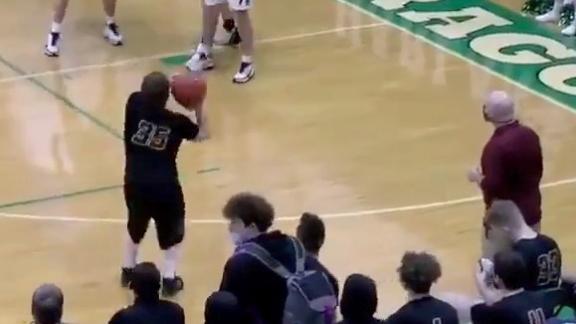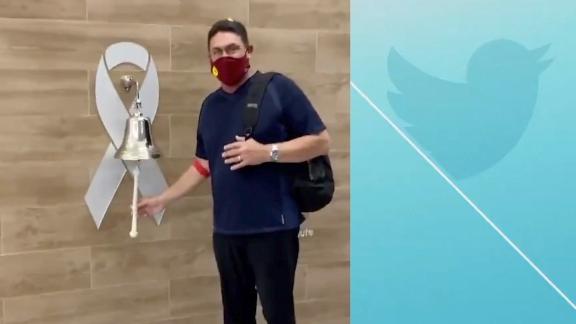It's four days later, and my head is still scrambled by the turn of events in the Belk Bowl. (Which somehow has yet to get a catchy nickname, like the Music City Miracle. I am proposing the Belk WTF-just-happened-to-my-Duke-Cover Bowl or the Belk holy-crap-how-did-Cincy-Cover Bowl.)
The only way for me to truly comprehend this situation was to turn the last 90 seconds of the game into an SAT-like math problem, for which there is a reasonable solution that doesn't require a Princeton Review course. I'm sure the geniuses at Duke appreciate me helping them work out their feelings in a rational, logical way. So here goes: If team A is as high as a 10-point underdog to Team B, and Team A has a first and goal with 1:30 seconds remaining in a tie game, what are the chances that Team B can still cover the double-digit spread?
In case you have forgotten, this is the exact scenario that unfolded Thursday night in the Belk Bowl. Duke, which had opened as a 10-point dog and closed as an 8.5-to-9-point dog (it got as low as seven over the past few weeks) had a first and goal in a game that was tied 34-34 with 90 seconds left to play. They were a couple of kneeldowns and a field goal away from winning a bowl game for their gracious coach David Cutcliffe. Instead, Duke running back Josh Snead fumbled, Cincy recovered and, four plays later, the Bearcats scored on an 83-yard touchdown pass.
That wasn't enough.
With Duke flailing in a last-chance drive, QB Sean Renfree was hit as he threw, leaving a floater for a Cincy linebacker, who plucked the gift from the sky and ran it back for a touchdown. What had been a sure Belk Bowl win for Duke turned into a miracle cover for Cincy.
So I ask, in my best prep-test language, what are the chances?
My first call was to Fezzik, two-time SuperContest champ and an actuary-turned-professional bettor. The man is good with numbers. "It was 99.99 percent that Duke would cover. The only realistic chance for Cincy to cover was a triple-OT win, beating the 7.5."
I wasn't satisfied. This was like knowing the answer without understanding the work. I needed the work. Next I asked Mike Perry, a spokesman for the online betting site SportsBook, if his bookmakers could work up some stats, since they offer in-running wagering. I figured their algorithm would have something from that exact moment in the game. But it was so unlikely a scenario that they had taken that option off the board. The only bet they were offering was a money line wager of Duke -600/Cincy +400. "It's really anyone's guess unless you can simulate the situation," Peter Childs, the site's live betting director, said in an email.
Still, I needed a resolution. On Friday morning I texted the SportsBoss, who has been a regular in the column the past couple of years. He has an MBA from a very fine private school and works in finance. He also moonlights as an analytics-based handicapper, applying everything he learned about advanced metrics to who will win and who will lose and by how much. I figured this would be the kind of math problem he'd enjoy tackling.
When we connected Sunday night, ostensibly to go over non-BCS title bowl games he likes over the next week (see below), he did, in fact, have a solution for me. The truth is, he didn't do anything revolutionary. He just did something very, very smart. He took the formulas already available, tinkered with the ingredients, and came up with something that made relative sense.
There is a book called "Mathletics: How Gamblers, Managers and Sports Enthusiasts Use Mathematics in Baseball, Basketball and Football." It was written by Wayne Winston, a professor at Indiana University's Kelley School of Business who has worked as a consultant to the Mavericks. The book has a nifty commercial cover, but make no mistake, it is not for the simpleminded. Open it up and it is as dense as a textbook, with lots of graphs and math formulas. It's exactly the kind of research that appeals to a guy like the SportsBoss.
Winston's website, waynewinston.com, allows you to download all the files he references in his book. Again, this is heady stuff, not to be trifled with or used by mere amateurs. I tried it, and shortly after my computer locked up, my head exploded. But one of the files he allows you access is called "collapses," and it has a formula for determining how likely the biggest breakdowns in sports history were to happen. Think the Blazers losing to the Lakers in the 2000 Western Conference Finals or the Oilers choking against the Bills in the 1992 wild-card game. It's fascinating stuff; miracles as math.
If you can understand it.
Fortunately, the SportsBoss can. He manipulated the formula for the Bills-Oilers, which includes phrases like "sigma for game," "fraction for game" and "sigma for rest" to determine the probability of a win/loss in the exact situation we saw last week. "The number I ended up with for the Duke-Cincy game was 3 out of 1,400, which is around .002," the SportsBoss told me.Really, it's no different than what any of us thought: The chances of Cincy covering were the most infinitesimal in sports. But at least now we know how infinitesimal. And when something as illogical as this happens, it's nice to have something concrete to hold onto.
Anyway, onto the bowl matchups the SportsBoss saw as being most advantageous between now and the BCS title game.
Gator Bowl
Matchup: Northwestern versus Mississippi State
Line: Northwestern minus-1.5




